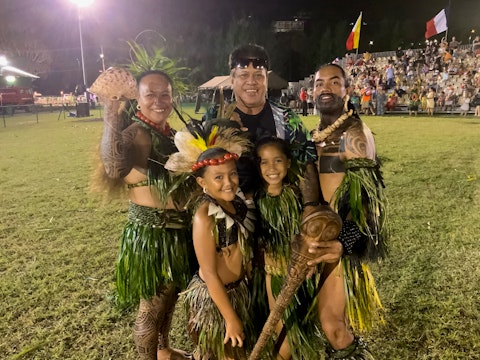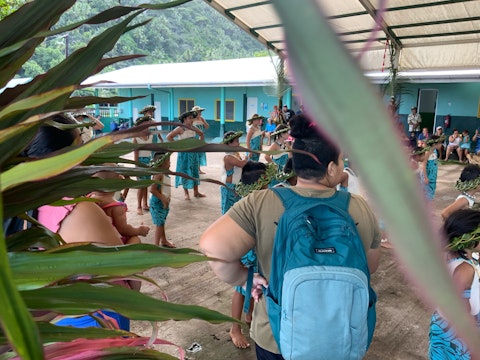The Pulse of Creation
Fatu Iva is the most isolated island in Te Fenua Enata (the Marquesas archipelago)
Fatu Iva is the most isolated island in Te Fenua Enata (the Marquesas archipelago)
It is endowed with lush vegetation, green enveloping us on all sides. As you enter the village of Omoa, you're quickly drawn in by a powerful rhythm. This sound comes from the making of the ahu ènata or kahu ènata in Marquesan, better known as Tapa (Tahitian name). Tree bark is beaten into a malleable non-woven fabric that can take on different shades depending on the species of tree used. This ancestral art was practised throughout Oceania, as well as in Africa, South America and South-East Asia.
In Polynesia, the tapa was used for rituals, to house newborn babies, as a shroud, and in everyday life as a garment, blanket or periodical protection. After the arrival of the colonists, the prohibition of many traditions/rituals and the forced conversion to the Occidental religion with the obligation to completely cover the bodies, this art was gradually abandoned and the transmission broken. Only in Fatu Iva does the art of Tapa-making continue to be practiced on a daily basis. Its use varies, however, and there is a new form of production, Tapa as a commercial object: it is stiffened flat to form a support similar to the paper on which tattoo designs are painted.
Tapa-making is essentially a woman's world. The beater used (ike in Marquesan) is carved from a very dense wood called ironwood, Aito or Toa in Marquesan (scientific name: Casuarina equisetifolia). In Fatu Iva, a long, flat, smooth basalt stone is used as the anvil. This stone and the beater have been handed down from generation to generation. Most of the old beaters have been stolen or sold. In Omoa, there's a sculptor who has started making Toa beaters in response to demand from the mamans who live on the island. He is the last to produce them. The carver dries the parts taken from the tree for several years. These new beaters are often thinner and have striations carved on two sides only, whereas in the past all four sides of the beater had striations of varying widths. The sound when working the bark seems different.
I asked around in the village. Emmanuel Tauapahatua Gilmore, a village elder, told me that when he was younger, he used to carve the beater as his father had taught him. He explains that he would go to a particular spot on the island, accessible by sea, at the foot of an ironwood forest. There he would collect pieces of this extremely heavy wood from a tree that had been dead for several years. The tree was already dead when he picked it up, which seems to be an important point that influences the quality of the sound as well as the overall strength of the final object. His father could spend a whole day finding the right piece to carve. In those days, people took their time to do things, money didn't exist.
This characteristic sound is powerful and plays an important part in the sound universe of the island's inhabitants. When the ear is sharpened, we can tell who is doing the work and whether the bark needs to be moistened a little more, or whether the master builder is using an old beater or one that has just been made. During my apprenticeship with the women of the island, I was able to experiment with attentive listening and the subtle nuances of percussion and resonance. Percussion is very much a part of Marquesan culture. It is found in stone and wood carving, in the art of tattooing (Patutiki), in the art of making tapa, in the preparation of certain dishes... It creates a sound and makes a mark, an impact, a drawing. It creates music, a rhythm that calls for singing and dancing. When you strike the bark, the vibration spreads everywhere, engaging your whole body. Little by little, you enter into a kind of trance. It puts you in a different state of consciousness. To listen to the original sound of this practice is to connect with the vibrations that enveloped each of the valleys on these small pieces of land in the middle of the great ocean where the Oceanian people had settled.








